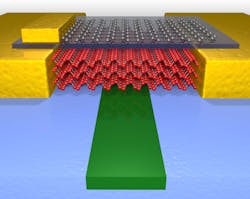The highly reactive element phosphorus—commonly found in match heads, tracer bullets, and fertilizers—can be converted to a stable crystalline form known as black phosphorus. University of Minnesota (Minneapolis, MN) researchers are using an ultrathin black phosphorus film only 20 atoms thick to demonstrate high-speed data communication on nanoscale optical circuits, showing vast improvement in efficiency over comparable devices using the earlier 'wonder material' graphene.
RELATED ARTICLE: Co-doped optical fiber serves as gamma-radiation sensor
The work, published in Nature Photonics, reveals that while the existence of black phosphorus has been known for more than a century, only in the past year has its potential as a semiconductor been realized. Due to its unique properties, black phosphorus can be used to detect light very effectively, making it desirable for optical applications. For the first time, the University of Minnesota team created intricate optical circuits in silicon and then laid thin flakes of black phosphorus over these structures using facilities at the University’s Minnesota Nano Center.
The University of Minnesota team demonstrated that the performance of the black phosphorus photodetectors even rivals that of comparable devices made of germanium—considered the gold standard in on-chip photodetection. Germanium, however, is difficult to grow on silicon optical circuits, while black phosphorus and other two-dimensional materials can be grown separately and transferred onto any material, making them much more versatile.
The team also showed that the devices could be used for real-world applications by sending high-speed optical data over fibers and recovering it using the black phosphorus photodetectors. The group demonstrated data speeds up to three billion bits per second, which is equivalent to downloading a typical HD movie in about 30 seconds.
"Even though we have already demonstrated high speed operation with our devices, we expect higher transfer rates through further optimization," said Nathan Youngblood, the lead author of the study. "Since we are the first to demonstrate a high speed photodetector using black phosphorus, more work still needs to be done to determine the theoretical limits for a fully optimized device."
While graphene has proven useful for a wide variety of applications, its main limitation is its lack of a bandgap. This means that graphene always conducts a significant amount of electricity, and this "leakage" makes graphene devices inefficient. In essence, the device is "on" and leaking electricity all the time.
Black phosphorus, on the other hand, has a widely tunable bandgap that varies depending on how many layers are stacked together. This means that black phosphorus can be tuned to absorb light in the visible range but also in the infrared. This large degree of tunability makes black phosphorus a unique material that can be used for a wide range of applications—from chemical sensing to optical communication.
"It is really exciting to think of a single material that can be used to send and receive data optically and is not limited to a specific substrate or wavelength," Youngblood said. "This could have huge potential for high-speed communication between CPU cores which is a bottleneck in computing industry right now."
The University of Minnesota research was funded by the Air Force Office of Scientific Research and the National Science Foundation.
SOURCE: University of Minnesota; http://discover.umn.edu/news/science-technology/black-phosphorus-new-wonder-material-improving-optical-communication

Gail Overton | Senior Editor (2004-2020)
Gail has more than 30 years of engineering, marketing, product management, and editorial experience in the photonics and optical communications industry. Before joining the staff at Laser Focus World in 2004, she held many product management and product marketing roles in the fiber-optics industry, most notably at Hughes (El Segundo, CA), GTE Labs (Waltham, MA), Corning (Corning, NY), Photon Kinetics (Beaverton, OR), and Newport Corporation (Irvine, CA). During her marketing career, Gail published articles in WDM Solutions and Sensors magazine and traveled internationally to conduct product and sales training. Gail received her BS degree in physics, with an emphasis in optics, from San Diego State University in San Diego, CA in May 1986.
